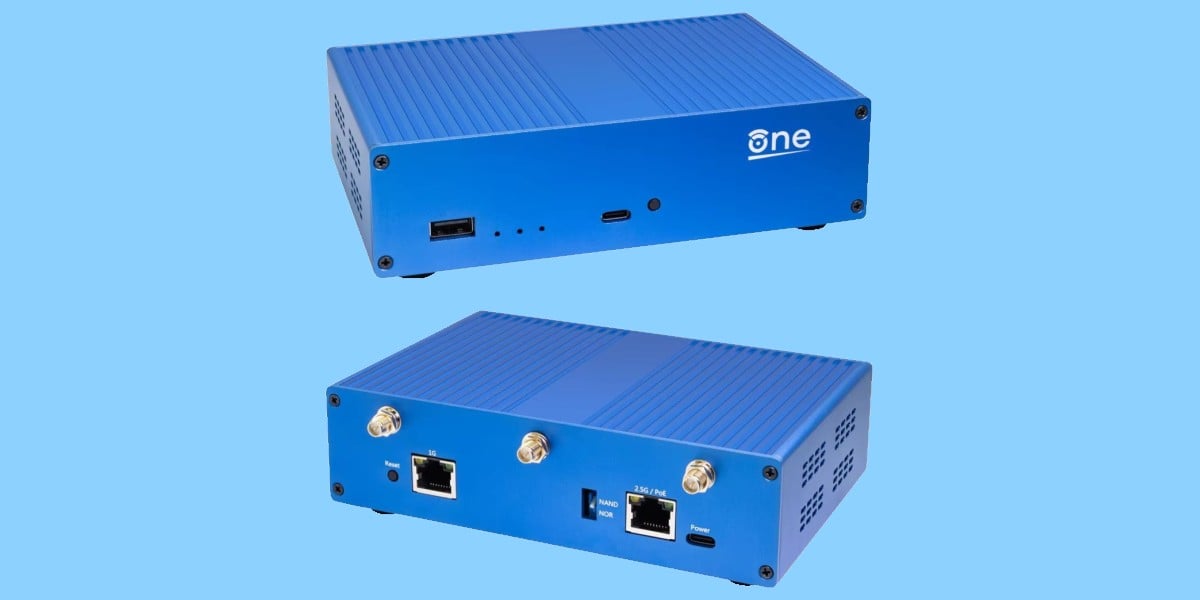So, how is this any better than the Router Mini PCs you can find in Aliexpress (random example)?
WiFi
The very example I provided comes with an mPCI-e slot to install a WiFi card of your choosing.
Also they have SIM card slots so you can install a data SIM card and set-up a fallback configuration that switches to it if your landline internet connection goes down.
Of course. But this one comes with WiFi onboard and a case with antennas if you go for the clothed option.
It’s Open source hardware too
Whilst that’s a nice slogan, in Electronics “open source” doesn’t mean anywhere as much as it does in Software because it’s generally just knowing which components go into the circuit, which is but a fraction of the work (laying out the board is a massive chunk of work, in some cases most of it, and at high enough clock speeds circuit design is an art in itself).
Mind you, I like the Orange Pi and Banana Pi guys, and the idea of an SBC designed for being an open source router is pretty appealing, though nowadays maybe pfSense would be a better choice than OpenWrt.
Finally this thing having only 2 ethernet ports + WiFi makes it little more than a regular $70+ SBC board + a box - something easy enough to put together by any technically inclined person - which isn’t exactly exciting.
Open hardware (by oshwa definition) would include the board layout
pfSense would be a better choice than OpenWrt
I heard pfSense had a hard time with wireless radios, and that’s where OpenWrt shines comparably. Is that not true?
Most of those run OpenWrt or PfSense. Assuming the hardware is well-supported by the open source software it runs, there’s a argument to be made that there’s no difference. There’s always the risk of them using some weird chipset that won’t be supported in a year’s time. The only difference is that the OpenWrt One is specifically designed for OpenWrt with well-supported hardware.
how good is openwrt these days? i used it a long time ago on tp link hardware are remember it was not too good…like adding own scripts, addons etc. and then i tried stuff like ipfire,ipcop and pfsense. pfsense was so much better and now opensense is quite good. how does current openwrt compare?
I’ve been using it on my last 2 routers, currently the Netgear WAX206 and I’m loving it.
It does what it’s supposed to. No complaints.
OPNsense is like comparing a bicycle to a car (in Europe) Both will get you there,the first one is more convenient most of the time for most users,but the second one is a whole class of “more powerful”. But it’s far easier to take a shortcut with a bike.
k. thanks. i really was thinking they made hughe progress now that they do dedicated hardware.
They don’t, as others have pointed out. It’s just a standard single board computer with some addons and a case.
I need this but 4G version…
GL.inet has some LTE routers with OpenWRT on them. I haven’t tried the LTE version, and the one (Shadow) I have has to be rebooted once a week, but that’s a really cheap one I was trying.
I need this router.
There are use cases for this router, but please don’t get the plastic clone sold by the same Chinese company that assembles the real thing. (The plastic clone costs a third, but doesn’t have detachable antennas and doesn’t accept mainstream OpenWRT because it uses an almost unknown CPU.)
Myself, when I need a high capability router (for me “capability” typically means “range”) I turn towards a Raspberry Pi and Alfa AWUS1900 wireless card. Yes, it lacks in throughput (USB is a severe bottleneck)… but with a bit of tweaking, you can talk out to 2 kilometers if terrain allows. :)
deleted by creator
This is link to CZ.NIC’s Turris offerings.
They ship to “many countries” besides Czech republic, according to their page.
The router itself is quite expensive at around 400 euros for the wifi model.
In case it is not obvious, they are primarily Czech domain registrar.
GTFO, clicking on “buy now” two times results in some shop which has “aliexpress” as the official partner.
This can’t be a product from the sources mentioned, can it?
It says its a BananaPi product, and BananaPi uses aliexpress as a distributor according to https://www.banana-pi.org/web/index.php?topclassid=155&classid=155&lanstr=en&wap=1
checks out afaik
Is it available only though aliexpress?
The next router I’m getting!
I’m glad it’s open hardware as much as open software, but I think I’ll wait to see what the OpenWrt Two looks like.
I’m fine with the looks and hardware, except I’m not upgrading again for a wifi 6 router. I’ll wait till they make a 7. 7 has a couple pretty big improvements over 6.
I’m late to the party but please consider this FOSS / liberated hardware option from thinkpenguin. Highly recommended.
Powered by usb-c, runs on librecmc
https://www.thinkpenguin.com/gnu-linux/free-software-gigabit-mini-vpn-router-tpe-r1400

The price is right for sure, but it’s still sad they didn’t shoot for wifi 7. It was a pretty big leap in latency reduction.
Mmh only two Ethernet ports? I guess it’s for people who use mostly wifi only?
It’s just the router, I guess. Provide your own switch for more ports.
Exactly this. With VLAN tagging you can plug that single 2.5Gb connection into a 48-port managed switch and effectively have up to 47 different NICs if that’s what floats your boat. They’d all share the 2.5Gb but that’s still more than a lot of small networks need.
In a shared 2.5Gb scenario as you describe, would fully pegged upload/download be 1.25Gb each? Could it do 2.5Gb in both directions simultaneously? Assuming no compute bottlenecks.
It’s full duplex so it’s 2.5Gb each way simultaneosly. Most NICs support half-duplex but I don’t know of any good reason to use that. I used to have a BananaPi based router that could comfortably saturate it’s gigiabit interface. I assume there’s some kind of offloading going on.
deleted by creator
Well the router I use today has 4 ports (and a built in modem for that matter, but I don’t use that).
I understand I can use a switch, but that means I’ll have to buy a switch in addition to this to replace my router.Which is not a bad thing, it’s more unix if you will. Router is a router, switch is a switch.
You provide your own switch and you choose the features: port count, port speed, vlan, etc — or get a 10€ switch if you don’t care. When a port breaks you replace the switch alone.
Multifunction tools are generally a tradeoff where you buy immediate convenience and pay with more ewaste and more money in the long run.
Good point.
I also wanted to chime in with the perennial point that while this device is a pure expression of the OpenWrt project, they also support hundreds of other devices including, amazingly, a number of large switches, so if you wanted to ditch the separate route appliance altogether you could get all the features with only switch hardware.
The audience of this router most likely already has a standalone switch within their network.
I have 3 but they’re not close to the router. (What I’m saying is: I’m likely target audience, but I don’t have an additional switch nearby, since so far any router I had also had a built in switch.)
But yeah, I get it. Modularity makes sense for repairability.
I still don’t understand why this isn’t a 2.5G WAN and 2.5G LAN. Is it assuming that people are going to be using it as a router on a stick with a 1G WAN?
I can’t tell if WAN is Wireless Area Network or Wide Area Network.
Wide area network. It’s basically the “internet” side of the router.
I know what a Wide Area Network is. I’m just saying the acronym is ambiguous since the advent of WiFi
lan is local area network
wan is wide area network
wlan is wireless local
wwan is wireless wanNot really. WAN has always been WAN. Wireless has always been WLAN.
WAN = Wide Area Network
WLAN = Wireless Area Network*WLAN = Wireless local area network
*Wireless Local Area Network
Given the 2.5Gb port also supports PoE in, I think the idea is that you can plug this into a 2.5Gb PoE port on a seperate managed switch and that’s the only connection you need; that’s certainly how I would use it. WAN connections could be plugged into that switch, along with the APs, user devices, servers, etc, with them seperated using VLANs. Assuming everything was gigabit except for that 2.5Gb link to the OpenWRT Thing™, you’d be hard-pressed to saturate that 2.5Gb port and you’d still have the gigabit port completely free for… whatever.
most likely because this device is mainly for wifi use, and/or limitation of the SoC.
Nerd here. You confuse me:
WAN is some up-/downstream port connecting intranets remotely in my novice book. The measurement G doesn’t refer to some advertisement-thingy in terms of wireless speed (but Gigabyte) - Maybe it’s some form of Generation; But then I lack everything including my false base knowledge. Additionally I have never encountered “2.5G LAN” ever before: Would you be able to shed light on my shortcomings? 2.5 x 8 is 20 Gbit. I didn’t read about that size yet.
I have never encountered “2.5G LAN” ever before
https://en.m.wikipedia.org/wiki/2.5GBASE-T_and_5GBASE-T
https://www.tp-link.com/se/business-networking/unmanaged-switch/tl-sg108-m2/
now you have ;)
WAN would be the Internet uplink port. A 2.5G WAN port is a 2.5 gigabit Ethernet port. 2.5 gigabit and o a lesser extent 5 gigabit Ethernet are a standard that’s becoming rapidly available on a lot of hardware. OP is stating that for a device shipping near the end of 2024, a new router that is shipping with only 1 GbE instead of 2.5 GbE is a problem.
You want your $90 wi-fi router to do what now?
I love the specs and the pricing. Will definitely check it out.
It would be nice if they would make one with 4 or more LAN ports with at least one of them 2.5G and no WiFi. I need multiple access points to get enough coverage. The built in WiFi is useless to me since it won’t integrate nicely with Unifi.
You can hook it to a switch and a Wireless AP… Now your networking is modular.
Turn it off then and use your own APs, it’s what I do in my home. I don’t have this specific router but I have a box with 2 eth ports, one goes to pppoe and the other to my home switch, where my APs are connected.










